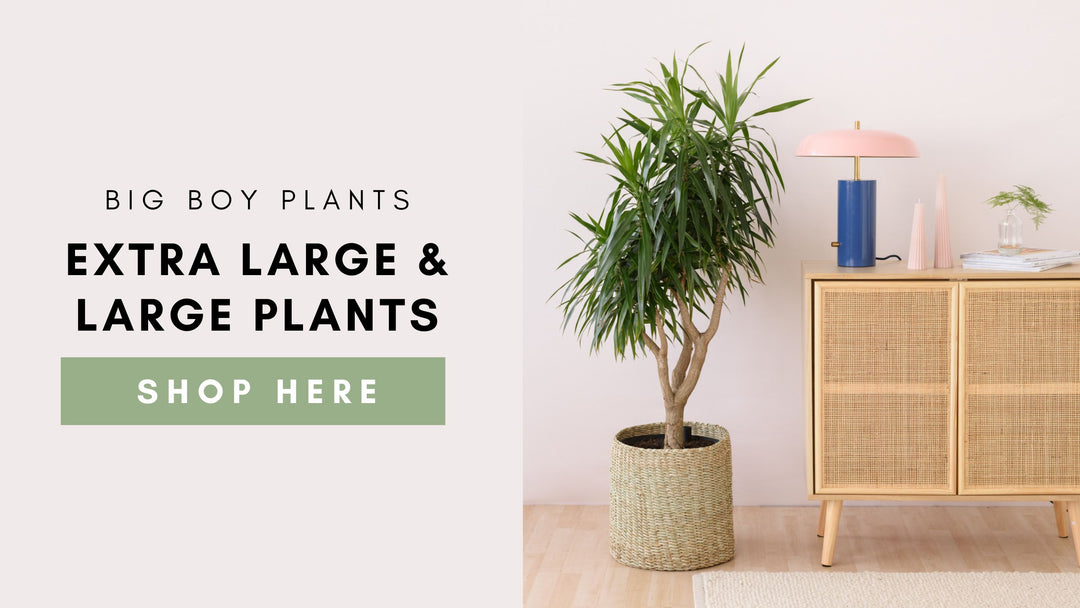Dragon Tree Care Instructions
Scientific name: Dracaena Sp.
Synonyms: Dragon Tree, Senjuang Wangi, Dragon Plant, Iron Plant
Dragon trees come in a variety of colours, shapes, and sizes, making them an attractive addition to any home or office. Many people love them because of their easy care requirements: they require significantly less water than most houseplants, are pest resilient, happy in lower light conditions, whilst also being great air purifiers.
Different types of Dragon Trees can be used to create desired statements indoors. With its robust trunk and wide, deep green foliage, Dragon Tree Alchemy is an awe-inspiring specimen. For a more lush and bushy look, the Dragon Tree Americana is a terrific option, and for those of you who want something with some beautiful contrast in the foliage, Song of Jamaica or Song of India are wonderful choices.
Dracaena is derived from the Greek word Drakiana, which means "female dragon," as the first variety discovered had stems that were deep red in color, likened to dragons' blood, hence its name. With two exceptions in central and tropical America, this genus is native to Africa, southern Asia, and northern Australia.
In response to its natural environment, the Dragon Tree is highly drought tolerant for a tropical species, and will retain water within its trunk, thus reducing their maintenance requirements. Furthermore, they're largely accepting of a variety of lighting conditions, including artificial light. All of these attributes make them popular for the office plant rental and home decorating markets.
The architectural nature of Dragon Trees makes them perfect for floor level house plant displays and they can look amazing when they're raised off the ground using a low stool. The striking contrast of Dragon Tree foliage and stems make them a popular accent piece within large spaces since they can grow quite tall, albeit very slowly.
NOTE: Dragon Trees are poisonous to pets. May cause some allergies in humans - Keep away from small children.
Dragon Tree (Dracaena) Common Symptoms
-
Sudden Leaf Drop or Droopy Leaves: Can be caused by overwatering. Asses your watering schedule and adjust accordingly, usually reducing it and letting the soil dry out completely in between watering. Also check potting soil and the pot to ensure that it is well draining. Check out more information here on identifying Overwatering and Underwatering.
-
Dry Leaf Tips & Edges: This is often a result of under watering and low humidity. Aim to water the Dragon Tree deeply once the soil has dried out completely, avoiding consistently soggy soil. If you are watering consistently, then consider raising humidity levels. Avoid placing your plant in a direct breeze and raising the moisture in the air by spritzing your plant regularly, several times a day.
-
Dry Round Patches & Streaks on leaves: This is caused by direct sun hitting the leaves. Move your Dragon Tree into a bright space avoiding direct sunlight.
-
Pale Foliage: Your plant is not getting enough light. Move your plant to a brighter spot, where it gets more optimal bright indirect light.
-
Yellowing Tips of Leaves: Discolouration is different to dry leaf tips. This symptom could be a result of too much fertilizer. Alternatively, it could be the result of using municipal tap water with fluoride. Assess your fertilizer schedule and fertilize less or use a weaker solution. And definitely switch to natural source of water should you be using municipal water. Or let the municipal water stand for a few days, to let any unwelcome chemicals evaporate first.
-
Pests: Dragon Trees are relatively resilient to pests, however can be targeted by Mealy bug in hot humid conditions. Treat any infestations immediately when identified, using either a Neem based oil or Pyrol for best results. Read on to find out more about common household pests.
Dragon Tree (Dracaena) Care Instructions
- Origin: Majority of the species native to Africa
- Height: In the wild, up ± 15 meters tall. Given pot size, indoors, likely only up to 2 - 3 meters maximum.
- Light: Medium to bright filtered light
- Water: Water the plant thoroughly and then allow the soil to dry out at least 75% between watering. Adjust watering frequency according to how much light your plant is receiving. Consider checking water level using a moisture meter - a guide is that a 40cm diameter plant needs deep saturation (use a hose pipe or 5l to water with, really mositening the soil, once every 6 - 8 weeks in Summer and around every 8 - 10 weeks in Winter.
- Humidity: Average room humidity is fine, however, if you find the edges of your leaves are dry and brown you should raise the humidity levels. You can do this by simply misting the leaves regularly with a spray bottle.
- Temperature: Dragon trees like comfortable room temperatures between 18°C – 26°C, they do not like temperatures to drop below 15°C unless it is for short period of time.
- Soil: Use all-purpose soil that is amended with bark or perlite for extra drainage. This ensures the plant does not remain overly wet after watering.
- Fertilizer: Feed once a month during Spring & Summer, with a good balanced organic fertilizer, when the plant is growing and in need nutrition.
- Repotting: Repot every 2 – 3 years during Spring, or when the plant clearly becomes pot bound. Replenish with fresh soil.
- Propagation: Cut a stem in multiple parts, at least 5cm long, and remove the leaves. Make sure to start the cut right underneath a stem junction. Place the cut off stem in a water filled clear container. Position the container in a bright place and exchange the water every 2 to 3 days. After a few weeks, first roots will develop. Once there are a good proportion of roots, plant into well-draining moist soil.
Plantify regularly stocks a variety of Dragon Trees in different sizes. Find them all here. Or Search for different sizes and attributes from the list below:
- Alchemy - prized for their solid stems, in large (±1.8 meters) and shorter (±1.1 meters)
- Americana - bushy, multi-stemmed in large (±1.8 meters)
- Angazi - lovely mid sized plant with beautifully coloured, elongated foliage
- Reflexa - hardy variety with shorter, curled leafs - in small and medium sizes
- Song of India - table top height with beautiful yellow shaded foliage
- Song of Jamaica - with different shades of green in medium and short formats





